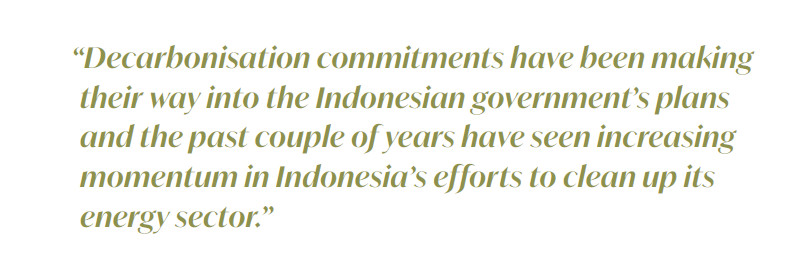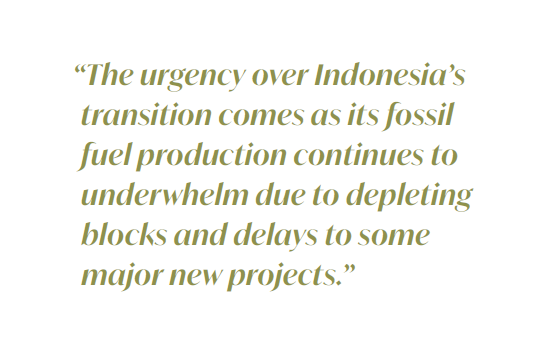Indonesia plots course from fossil fuels to low-carbon future [Gas in Transition]
Six months on from the G20 Summit in Bali last November, where a $20bn package to support host country Indonesia’s energy transition was unveiled, the path to a net-zero future for the Southeast Asian powerhouse is coming into view amid growing potential for Jakarta to accelerate its decarbonisation momentum.
A smooth and just transition will be key for fossil fuel-reliant Indonesia, tipped to be the fourth-largest economy in the world by mid-century compared with 16th last year. Once the world’s biggest LNG exporter, Indonesia remains a key regional seller of oil and gas but domestic production of both fuels is falling yearly. Declining export revenues and the eventual ending of fossil fuel subsidies will have ramifications for the fourth-most populous country, where at least 9% of people live in poverty.
It remains early days for Indonesia’s transition as its energy system is currently not on track for a net-zero future. Coal, oil, and gas still make up most of the country’s energy mix – between 2012 and 2021, Indonesia grew its installed coal-fired power capacity by 21 GW, and its gas, oil and diesel capacities by 10 GW.
Considerably more capital than the $20bn committed by the G7, the EU and others in Bali will need to be raised and mobilised for Indonesia to reach net-zero. The country will need to undergo several regulatory and market reforms, kick-start initial investment in low-carbon sources and ultimately coordinate public and private sources to organise large pools of capital.
But a rapid shift towards renewables, greater transparency and implementation of climate commitments, and a fair and sustainable transition away from coal can propel the Asian country to reach net-zero by 2050, creating significant investment opportunities primarily in low-carbon power supply and electric vehicle sales. The latter in particular will be a boon for Indonesia’s aim to become a global battery manufacturing hub.
Economic vibrancy to underpin energy transition
Over the coming decades, Indonesia will play a key role in the global economy enabled by its rapid development. After hosting the G20 Summit in November, the largest economy in ASEAN will want to spur climate action and progress as it sets the energy transition in motion.
Decarbonisation commitments have been making their way into the Indonesian government’s plans and the past couple of years have seen increasing momentum in Indonesia’s efforts to clean up its energy sector – mainly through the deployment of low-carbon energy technologies.
The next three decades will see Indonesia rapidly develop and play a key role in the global economy and energy transition. Credible pathways for reaching net-zero by mid-century are still within reach for Indonesia, but this will require decisive action from policymakers – including a push on renewables to reduce power sector emissions. Indonesia’s power demand is expected to grow fivefold by mid-century, while power systems will expand twelvefold in a net-zero scenario.
Strong economic development, rising population and urbanisation means Indonesia’s GDP is projected to increase fourfold by 2050 compared to last year, according to the International Monetary Fund (IMF). This rise will also outstrip population growth, with GDP per capita anticipated to expand threefold from $4,350 to $15,700 over the same period.
The IMF expects Indonesia to make up 2.5% of the global economy in 2050, doubling from around 1.2% in 2022. This positive macroeconomic outlook bodes well for businesses interested in tapping into Indonesia’s energy sector.
Investment spree
Research from BloombergNEF suggests accommodating a net-zero future by 2050 will require Jakarta to unlock and mobilise more than $3.5 trillion of investment to decarbonise both energy supply and demand. This implies annual spending of around $122bn from 2022 to 2050 – equivalent to 9% of Indonesia’s GDP last year and representing an enormous investment opportunity.
Energy supply-side investments under a net-zero scenario (NZS) will account for 48% of total investment, equivalent to about $58bn annually by 2050. These pertain to the assets that produce and supply fuels and electricity – in the case of Indonesia, they include power generation and grid capacities, hydrogen production, storage, and transport, carbon capture and storage (CCS), and fossil fuel processes.
Low-carbon power will be the biggest driver of energy supply investment, comprising 54% of the total supply-side capital expenditure. From 2022 to 2050 roughly $5 must be directed to low-carbon energy supply for every $1 spent on fossil fuels for Indonesia to hit net-zero.
The production, storage, and transport of hydrogen presents an investment opportunity of $100bn by 2050, mainly driven by storage, which will require $58bn. Moreover the pipeline transport, production of green hydrogen through renewables-powered electrolysers, and blue hydrogen production through steam methane reforming altogether will require a combined $42bn of investment.
NZS by 2050 represents a $58bn investment opportunity for non-power CCS – $38bn of which will be directed to the transport infrastructure needed to safely deliver CO2 from capture to storage sites. Another $13bn will be required for storage with the remainder going towards capture technologies.
But for the country to reach net-zero by mid-century, spending on low-carbon energy demand will need to outpace spending on supply. As much as $1.85 trillion could be spent on low-carbon energy demand by 2050, with electric vehicle sales set to take the largest share at $1.59 trillion. This comes as their uptake is bound to accelerate as electrification is set to become the main means for Indonesia to decarbonise road transport.
Other major areas for demand-side investment in Indonesia will include heat pumps and recycling plants for sustainable materials, representing a growing set of opportunities in the next phase of the energy transition.
Sunset on fossil fuels
The urgency over Indonesia’s transition comes as its fossil fuel production continues to underwhelm due to depleting blocks and delays to some major new projects. In mid-April the Indonesian upstream regulator said oil and gas lifting in the first three months of this year rose from a year earlier but came in below targets set in the state budget due to unplanned shutdowns.
Crude oil lifting stood at 612,700 barrels/day in the first quarter while gas lifting was at 5.4bn ft³/day, compared with 611,700 b/d and 5.32bn ft³/d in Q1 2022. The state budget has targeted 660,000 b/d of oil and 6.16bn ft³/d of gas distribution for this year.
Declining oil production – falling by 3.1%/year from 2011 to 2021 – prompted Indonesia to prioritise domestic use of gas as a large amount of domestic electricity was produced from oil until relatively recently. The switch to gas-fired generation was seen as a way of freeing up oil production for use in higher value applications such as transport, but domestic gas production is suffering from declines too.
Indonesian gas output has been falling for years, and there are few signs that the trend will be reversed – production fell from 82.7bn m3 in 2011 to 59.3bn m3 in 2021, according to statistical data from BP – meaning that there is insufficient gas to physically supply both the domestic and export markets.
Indonesian gas consumption fell from 42.7bn m3 in 2011 to 37.1bn m3 in 2021. Over the same period, the share of gas in the primary energy supply fell from 22% in 2011 to 17% in 2021, according to the ministry of energy and mineral resources.
Dwindling supply means LNG exports have stagnated too. In Q1 2023 the country produced 50 cargoes of LNG – around 24% of the full-year target – and exported 35 cargoes. These figures put Indonesia just about on track to maintain last year’s output, when LNG production and exports stood at 196 cargoes and 140 cargoes respectively.
Treading water while other major exporters like Qatar, the US and Australia invest in new capacity suggest a muted outlook for Indonesian LNG exports, which have almost halved from 28.7bn m3 in 2011 to 14.6bn m3 in 2021.
Reduced exports have not increased gas availability either, leading to a shrinking share of gas in the power generation mix. Coal-fired power – a key focus of the $20bn energy transition deal announced in Bali last November – has taken up the slack, with thermal coal making up 61.4% of total electricity generation in 2021 compared with 54.5% in 2016.
Cutting out coal
Coal has consistently accounted for more than half of Indonesia’s primary energy mix and its dominance reflects the importance of the dirtiest fossil fuel to the local economy. The Asian country is one of the largest coal exporters and among the top consumers of the fuel worldwide. Coal mining processes have contributed to more than 10% of the nation’s export income.
Indonesia moreover is among the few markets around the world where coal-fired power is the cheapest source of bulk generation, despite rising coal prices in the past year. This comes down to a few protectionist regulations, such as obligating coal miners to sell 25% of their mined output to the domestic market at a capped price of $70/metric ton.
Indonesia will need to switch away from its coal-heavy energy matrix to achieve net-zero by 2050, with development of lower-carbon alternatives urgently needed. Net-zero by 2050 will require annual investment in fossil fuel processes to halve as consumption drops. Local analysts expect investment in fossil fuels to reach $9bn/yr between 2022 and 2050, while historical investment for fossil fuels consistently exceeded $18bn/yr.



